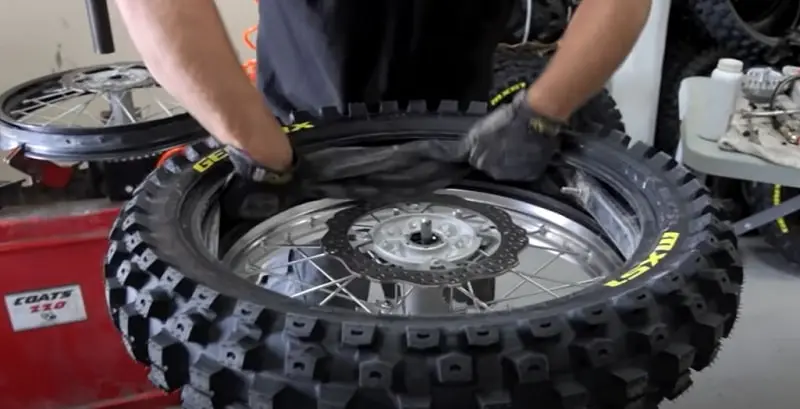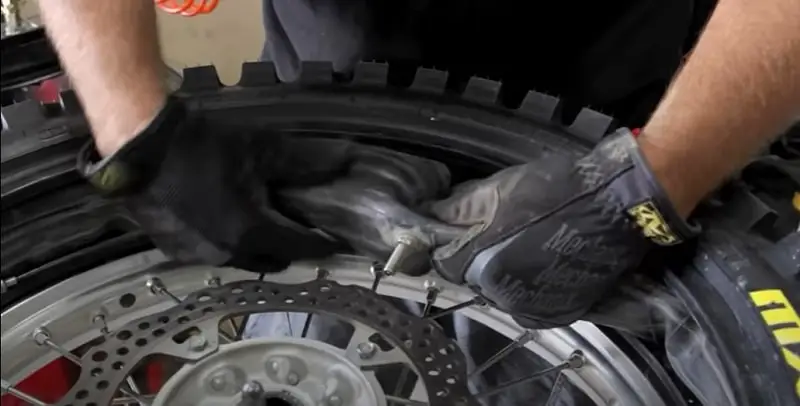Motorcycle tires have tubes for a few reasons. One reason is that tubes help to maintain proper air pressure in the tire.
The air pressure in a motorcycle tire is crucial for several reasons, including providing the appropriate amount of support for the bike and rider’s weight and ensuring that the tire maintains good contact with the road.
Another reason that motorcycle tires have tubes is that they provide an additional layer of protection for the tire.
The tube is located inside the tire, between the tire itself and the wheel rim, and it provides a barrier between these two components. This helps to prevent damage to the tire from the wheel rim.
In addition, tubes make it easier to repair a punctured motorcycle tire. If a tire goes flat, the tube can be easily patched or replaced, allowing the rider to return to the road quickly.
This is much easier than trying to patch a hole in a tubeless tire, which can be time-consuming and difficult.
Using tubes in motorcycle tires provides several important benefits, including maintaining proper air pressure, protecting the tire and wheel rim, and making it easier to repair a punctured tire.

Is It Ok to Put a Tube in a Tubeless Motorcycle Tire?
In general, putting a tube in a tubeless motorcycle tire is not recommended. This is because tubeless tires are designed to be used without a tube, and adding a tube can compromise the performance and safety of the tire.
Tubeless tires are designed to be airtight and hold air without needing a tube. However, when a tube is added to a tubeless tire, it can create a weak point where air can escape.
This can lead to a loss of air pressure, which can cause the tire to go flat and potentially create a dangerous situation for the rider.
In addition, using a tube in a tubeless tire can cause the tire to heat up faster than it would without a tube. This can lead to excessive wear on the tire and potentially cause it to fail.
If a tubeless motorcycle tire goes flat, it is generally better to patch the hole or replace it entirely rather than try to put a tube in it.
If you need help with how to do this, it is best to seek the advice of a professional mechanic.
How Do You Tell If a Tire Is Tube or Tubeless?
There are several ways to tell if a tire is tube or tubeless. One way is to look at the tire itself. Tubeless tires usually have a small “TL” or “tubeless” marking on the tire’s sidewall, indicating that it is designed to be used without a tube.
Another way to tell if a tire is tube or tubeless is to look at the wheel rim. Tube-type tires will have a separate inner tube inserted into the tire and then inflated, while tubeless tires will be mounted directly onto the wheel rim.
If the tire is mounted directly onto the wheel rim without a separate inner tube, it is likely a tubeless tire.
If you are still trying to decide whether a tire is a tube or tubeless, you can also check the owner’s manual for your motorcycle.
This should provide information on the type of tires recommended for your bike. Alternatively, you can consult with a professional mechanic who will be able to determine the type of tire you have.
What Happens If You Get a Puncture on a Tubeless Tyre?
If you get a puncture on a tubeless tire, it will usually go flat. This is because the tire is designed to be airtight and hold air without needing an inner tube. So when a hole or puncture occurs in the tire, air will escape, and the tire will go flat.
If you get a puncture on a tubeless tire, you must repair the hole to get the tire inflated and back on the road.
This can be done by patching the hole or using a tire plug, a small plug inserted into the hole to seal it. Alternatively, you can replace the tire entirely if the puncture is too large to be easily repaired.
If you need help repairing a puncture on a tubeless tire, it is best to consult a professional mechanic. They will be able to help you fix the puncture and get your tire back in working order.
Can a Tubeless Tyre Survive a Nail?
A tubeless tire can survive a nail, but it depends on the nail’s size and location and the tire type.
In general, tubeless tires are more resistant to punctures than tube-type tires because they do not have an inner tube that can be punctured.
However, if the nail is large enough or is located in a critical part of the tire, it could cause a puncture that cannot be easily repaired.
If you run over a nail with a tubeless tire, it is important to inspect the tire carefully for any signs of a puncture.
If you notice a nail stuck in the tire, try to remove it carefully and inspect it for any holes or punctures. If you find a puncture, you must repair it to prevent the tire from going flat.
If you need help with repairing a puncture in a tubeless tire, or if the puncture is too large to be easily repaired, it is best to consult a professional mechanic. They will be able to help you fix the puncture and get your tire back in working order.
How Long Does a Tubeless Tyre Last?

The lifespan of a tubeless tire will vary depending on several factors, including the type of tire, the type of motorcycle it is used on, and the riding conditions.
In general, tubeless tires are known for their durability and can last for several thousand miles before needing to be replaced.
One factor that can affect the lifespan of a tubeless tire is the type of motorcycle it is used on.
For example, tires on a high-performance motorcycle ridden aggressively will likely wear out more quickly than tires on a cruiser or touring motorcycle ridden more gently.
Another factor that can affect the lifespan of a tubeless tire is the type of tire itself. Some tire brands and models are known for their durability and can last thousands of miles, while others may need to be replaced more frequently.
Therefore, choosing a high-quality tire that is well-suited to your motorcycle and riding style is important to maximize the tire’s lifespan.
Overall, the lifespan of a tubeless tire can vary depending on several factors, but with proper care and maintenance, a tire can provide many miles of reliable service.
Previous Article: Why Do Motorcycle Tires Crack?
Next Article: Why Do Front Motorcycle Tires Wear on One Side?